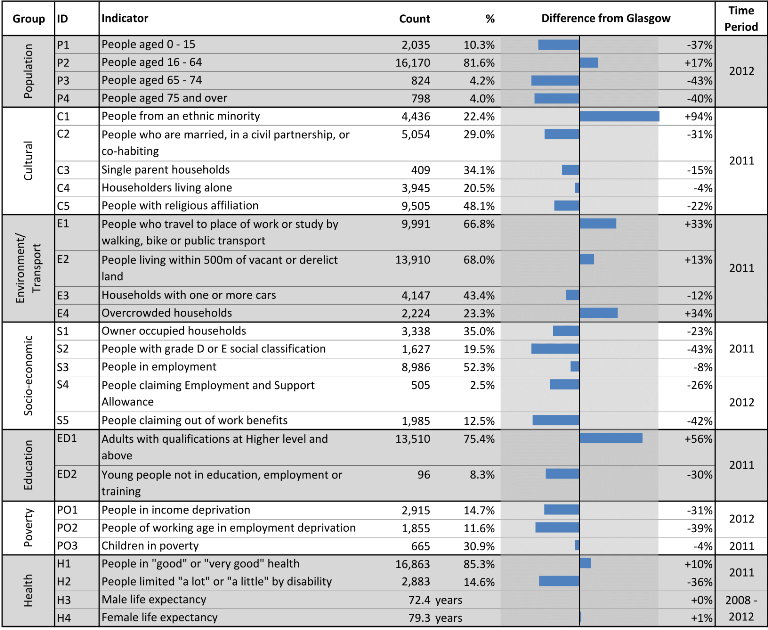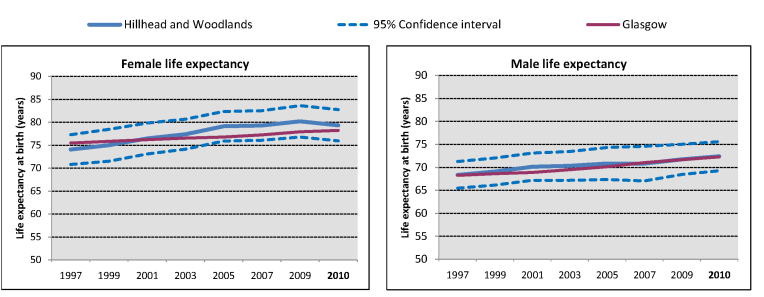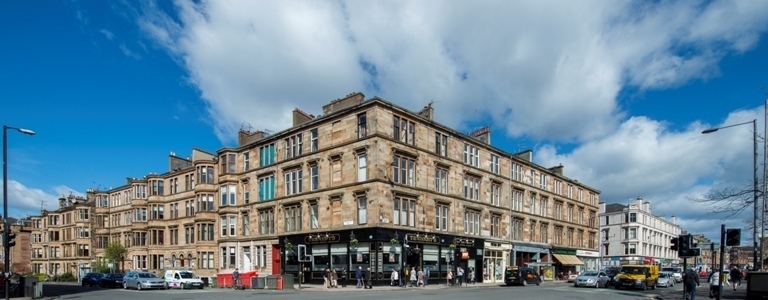Hillhead and Woodlands
*Please note that this profile is based on data from the 2011 Census.*
A printer friendly version of this neighbourhood profile can be downloaded here.
Hillhead and Woodlands is a neighbourhood in the north west of Glasgow with a population of 19,827.
Neighbourhood comparisons with Glasgow
Women live, on average, seven years longer than men in Hillhead and Woodlands. Life expectancies of men and women in the neighbourhood are very similar to the Glasgow average. The percentages of employment-deprived people and ‘young people not in employment, education or training’ are also particularly low compared with the Glasgow and Scottish averages. More than one-fifth of the population are from an ethnic minority group.
 Neighbourhood trends
Neighbourhood trends
 Life expectancy for females has risen above the Glasgow average in Hillhead and Woodlands. Male life expectancy has remained very similar to the Glasgow average throughout the time period shown.
Life expectancy for females has risen above the Glasgow average in Hillhead and Woodlands. Male life expectancy has remained very similar to the Glasgow average throughout the time period shown. The population in Hillhead and Woodlands increased by 8% between 1996 and 2012, largely due to an increase in the number of 16-44 and 45-64 year olds. The percentage of the total neighbourhood population from a minority ethnic group increased from 15% in 2001 to 22% in 2011. The percentage of the population from an ethnic minority group remained considerably higher than the Glasgow average between 2001 and 2011.
The population in Hillhead and Woodlands increased by 8% between 1996 and 2012, largely due to an increase in the number of 16-44 and 45-64 year olds. The percentage of the total neighbourhood population from a minority ethnic group increased from 15% in 2001 to 22% in 2011. The percentage of the population from an ethnic minority group remained considerably higher than the Glasgow average between 2001 and 2011.
Notes
A document giving detailed notes and definitions for the information presented in this profile can be downloaded here.
An Excel workbook containing the data used in all of the profiles can be downloaded here. This workbook also includes alternative output formats and further breakdowns of some of the variables.
1. Data sources: Scottish Index of Multiple Deprivation (SIMD) 2012, Census 2011, Census 2001, HMRC, NOMIS, National Records of Scotland (NRS) and Scottish Government.
2. Populations presented in the population trend chart and used to calculate life expectancy estimates are taken from NRS small area population estimates and are based on: the 2001 Census for the years 1996-2001; both the 2001 and 2011 Census for the years 2002-2010; and the 2011 Census for the years 2011-2012.
3. The Income deprivation and Employment deprivation indicators are derived from SIMD 2012, more information on this deprivation index can be found at: http://simd.scotland.gov.uk/publication-2012
4. Life expectancies are calculated based on population estimates and death registrations. 95% confidence intervals have been added on the graphs to give an indication of their accuracy. The x-axes of the life expectancy graphs give the mid-year for each life expectancy estimate, e.g. 2010 represents the life expectancy estimate for the period 2008-2012.
Glasgow City Council have also produced neighbourhood profiles based on data from the 2011 Census 2011 which can be accessed via this link.
